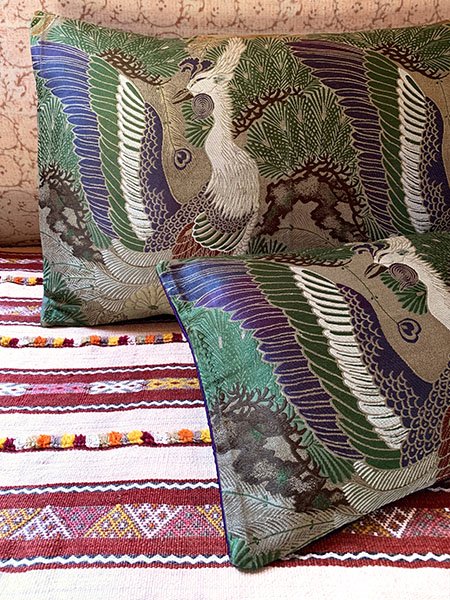Detail of a 19th-century silk obi in Tamerlane’s Daughters’ textile archive
OBI
Obi were long sumptuous sashes used in traditional Japanese dress to fasten kimono robes.
The most formal and decorative element of traditional attire – typically outshining and outpricing the kimono – antique obi are widely admired for their astonishing artistic detail.
No expense was spared in their creation, often incorporating liquid gold and ground mother of pearl.
An Art Form
In Japan, ceremonial obi were viewed as works of art on par with painting.
Just as wealthy Europeans commissioned portraits, affluent Japanese commissioned obi. The motifs and colours – each imbued with deep symbolism – were carefully chosen to reflect what was important to the wearer.
Obi were considered part of a family’s wealth.
A 19th-century silk obi from the collection of the Museum of Fine Arts, Boston
‘Lady Preparing to Tie Her Obi’ by Utagawa Toyokuni, circa 1800
Different Obi, Different Impact
It was the obi, not the kimono, that determined the formality of an outfit.
The same kimono could be worn in vastly different circumstances depending on which obi it was paired with, and how the obi was tied.
The Longest Garment in the World
Traditional obi measured 4 metres (13 feet) in length.
For this reason geisha – who unlike most women dressed daily in the cumbersome sashes – employed male dressers, otokoshi, to help lift and tie their obi.
Arranging an obi, late 19th century
Young maiko dressed in a garish obi reserved for brides and apprentice geisha, early 20th century
Youth Shining Bright
The most extravagant – often outright flamboyant – obi were worn by young brides and apprentice geisha.
Older women stayed away from ‘attention-seeking’ designs, opting instead for elegant patterns in muted colours.
The Royal Colour Purple
The colours and motifs of an obi were never a purely aesthetic decision.
Purple was the colour of the imperial household. Pastels were associated with the nobility. Bright red and yellow were the prerogative of young women, with dark blue and brown reserved for mature ladies.
Within these parameters set by colour, auspicious designs were created to reflect the wearer’s rank and character, but also her hopes and dreams.
Popular design elements included the crane and pine representing longevity, bamboo denoting strength, and the plum blossom symbolising beauty.
The phoenix, mythical and immortal, was identified with the emperor and his family.
'Seated Woman' by Kusakabe Kimbei, 1890
Celebrated geisha Sadayakko in a maru obi, 1901
Maru Obi
Most highly regarded was the maru obi.
Exceptionally wide and ornate, it was patterned on both the inside and outside.
Maru obi were typically created from elaborate silk brocades woven with precious gold and silver threads. The finest examples came from the famed Nishijin district of Kyoto.
Because of their stiffness and exorbitant cost, maru obi gradually became obsolete.
Tamerlane’s Daughters Museum-Quality Antique Obi
Karina uses only antique maru obi – the most ornate type of obi – in her work. Most date to the 19th and early 20th century.
Their craftsmanship and artistic detail are testimony to a culture, an era, that prized creativity while remaining committed to an ancient artisanal heritage.
Detail of a Tamerlane’s Daughters cushion created from a 19th-century silk maru obi featuring the phoenix and colour purple – hallmarks of the imperial court
Our collections of Couture Cushions made from antique silk obi are available exclusively through our
ONLINE SHOP









